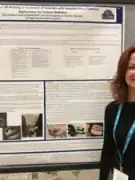
ASHT member Mary Matthews-Brownell recently worked with a rehabilitation engineer to provide a veteran with loss of hand function a 3D printed orthosis. She also presented this work at the ASHT 40th Annual Meeting.
Stratasys VA Initiative Update: 3D Printed Orthotic Gives Veteran a Helping Hand
by Sarah Saunders | Jan 22, 2018 |
When our veterans return home from fighting for our country, they deserve all of the help we can give them. Top 3D printing solutions company Stratasys has used its innovative technology multiple times to make custom 3D printed prosthetics and orthotics for veterans, even partnering with the US Department of Veterans Affairs (VA) last year on an initiative to launch one of the first collaborative 3D printing hospital networks in the US.
Stratasys worked with the VA Center of Innovation (VACI) to install 3D printers in five VA hospitals across the country, including in Washington and New Mexico. The company recently shared a success story from the initiative, detailing how an occupational certified hand therapist from VA Puget Sound and a rehabilitation engineer from the Albuquerque VA worked together to give a veteran with loss of hand function a 3D printed helping hand.
Hand therapist Mary Matthews-Brownell has been working with 37-year-old veteran Newton, who was referred to her about six years after complications from combat injuries caused surgeons to amputate his right pinky finger. He was having a hard time holding tools, which was necessary for his job in a warehouse distribution center, and writing legibly, due to muscle spasms and sharp phantom limb pain, so Matthews-Brownell fabricated a hand-based orthotic for him to use.
According to VACI Innovation Specialist Beth Ripley’s Stratasys blog post, “In large part a labor of love, the bending and shaping of a hand orthotic takes time, skill, and an in-depth understanding of human anatomy and the needs of the patient.”
While the hand orthotic kept Newton free from pain while driving, working, and taking care of his kids, the brace wore out quickly and needed to be replaced often, which meant Newton making an appointment, traveling a long way to the VA hospital, and Matthews-Brownell making him a new one. Newton also spends a fair amount of time volunteering in the Philippines, and was concerned about what to do if he damaged an orthotic while far away from the hospital – it would be impossible for him to purchase an off-the-shelf brace to replace his custom orthotic.
That’s when Matthews-Brownell thought about using 3D printing technology as a solution.

